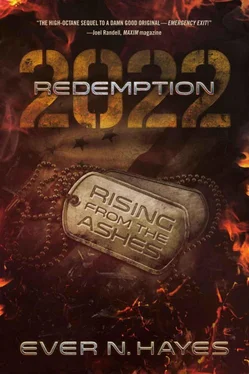From Area 52 the DTF controlled satellites that maintained constant watch over all of the islands, and they could zoom in close enough to count the freckles on someone’s arm if necessary. This was government prying, spying, and blatant disregard for privacy at its most intrusive level. With the infrared, see-through, and HD optical technology at their hands, they could quite literally watch anyone in Hawaii do absolutely anything—anytime, day or night. But no one even knew about it to complain.
There was one exception to the surveillance web. I had initially requested that Redemption and Ni’ihau be excluded from the spy net altogether, but Barnes had been uncomfortable with that idea. I understood his objection. That was far too much “dark” space for a potential problem to come from.
He was however willing to exclude Redemption Island and the channel around us. He didn’t mind our activities being invisible—since nothing could approach or hide beyond our circle unseen—and Barnes made sure each of the four operatives was clear on that. For insurance purposes, I had Keena—the Pack’s tech expert—learn the system operations and had the operatives set her up with a mobile system she could run from her room in Blake’s house. From there she would be able to access, and scroll through, all of the screens in Area 52. We had nothing to hide, but we didn’t like being watched— who does —and on the off chance the enemy did break into Area 52 at some point, I didn’t want anyone to be able to follow the Pack’s responsive movements. Governor Barnes was placing a lot of trust in me with this—I understood that—but the Pack was technically his Black Ops. He let it go.
I had no choice about the tablets that monitored our dog tags though and didn’t fight that. I understood the significance of that specific connection and security measure. Even if they couldn’t see us from the Hexagon, they needed to know where we were.
While Keena accustomed herself to the ins and outs of the entire system, I led the rest of the Pack up the 3,922 steps to the Shield’s transceiver—the “Eye.” I’d only been up there once before—with Governor Barnes—but the panoramic view of the islands and the Pacific was just as stunning the second time. On clear sunny days like this one, Kaneohe Bay glimmered like a field of diamonds. It was hard to adequately describe, and no wonder so many people had tried to climb up there. I showed the Pack where the backup generator was that could power up the Shield in the event the island or the Hexagon experienced a blackout. In the worst-case scenario, someone would have to race all the way up here—a good twenty-minute vertical sprint—and turn it on manually. As no one had ever done it before, there was no telling what would happen to the person who was up here when the Shield activated, especially if it was wet or— worse—mid storm. Hopefully we’d never have to find out.
Returning to Area 52, I led the Pack down a locked hallway to a giant gray door with a stenciled elephant painted on it. I had decided to take the team into this room—the Elephant Box—and reveal its contents. It was a risk, but there had to be absolute trust between us, and this was my way of showing my investment in that trust—and in each of them.
The Elephant Box was large enough to hold a dozen adult elephants, or two dozen—if you added a top layer—since it was two stories. The walls were dark gray and streaked or cracked—like elephant skin—but they had nothing to do with the name. The architect was merely a Republican. Fortunately he wasn’t a Democrat .
I watched as the Pack took in the contents of the box. “Whoa.” Keena was shaking her head. “Is that the actual Declaration—”
“Of Independence?” I smiled. “Yes. Yes, it is. Pretty much anything the government deemed too important to risk losing is here. The Bill of Rights, the Constitution, money plates, the first version of the Bible in English, the first of each version of the American flag—even the two Mount Suribachi flags from Iwo Jima. Martin Luther King Jr.’s “I have a dream” speech is in that cabinet, as is the Gettysburg Address and the Emancipation Proclamation. Every important document in American history is in this vault.”
Deacon was holding a hat in his hands. “And Lincoln’s top hat.”
“Yes, that too.” I caught it as Deacon tossed it to me. “Blake, Jack’s green jacket from his eighteenth major is in a fire box over there.” I nodded at a wall of black cabinets.
“Seriously?” Blake loved golf. “Whose idea was that? Had to be Clinton’s.”
“No way,” Deacon replied. “My money is on Obama.”
I shrugged. Who knows? “And all those hard drives contain every newspaper ever printed in digital form. There are building plans, instructions on pretty much every invention with all the patents, archives and archives of digitized books—you name it. Pretty much whatever you need to start a country over at some point.”
There was a chorus of “wows” and “holy craps” in response. What else could you say?
“This is crazy.” Blake shook his head. “When you mentioned the Elephant Box, I thought it was going to be just a box—maybe a large trunk or something.”
Keena laughed, and a second later Blake caught his own unintentional pun. “You know what I mean.”
“Well, there was a trunk in here too,” I replied. “Essentially a file cabinet or safe. I took that with me to the island. It’ll go in the vault under Blake’s office when we get that bunker finished.”
“What was in the trunk?” Deacon asked. “Can you even tell us?”
“Sure. It has hundreds of zip drives and packs of books with the design plans and locations for all eight of our government safe houses, plus NORAD and the White House. It had all the codes for our national and space missile silos and carriers—that kind of stuff. Also, there was a giant roman numeral four etched into the trunk, which makes me think there may be a few more of these trunks out there—perhaps in each of the safe houses.”
“Man.” Twix shook his head. “That’s huge. No wonder you wanted to build that damn bunker.”
I laughed. “Didn’t make sense otherwise?”
“I mean… I don’t know… not really.” Twix smiled. “It’s a lot of work for a room full of rope and guns.”
“And an ATV.” Blake playfully shoved Twix.
“Oh yeah, I forgot the ATV.”
“You said eight safe houses?” Royce asked, ignoring the conversational detour.
“Yes, though I believe there are ten if you count this, the White House, and NORAD.”
“So where are the other seven, Danny?” Deacon asked.
“I haven’t looked up specifics, but I can tell you their names from the book—Wrigley, Anaheim, Mackinaw, Alcatraz, St. Louis, Orlando, and Brooklyn.”
“Do you think they have this kind of stuff in those places too?” Keena gestured at all the artifacts. “Or people—other survivors?”
“People? Maybe.” I shrugged. “But I think this is essentially the treasure chest. This entire wing was built for presidents. None of them used it, but it was always going to be the safe house—the Camp David—for presidents when they came west on vacation. The government was in the process of moving all its defense systems and the rest of our national treasures here to the Hexagon before the attacks.”
It made sense.
Clearly there weren’t many people who knew about these rooms—these bunkers—but the vice president had known, so there were probably others who knew. Was it possible the general at NORAD knew about the vault in this bunker? Was it possible he knew about the other bunkers? There was something out of place with this entire NORAD scenario. I was convinced we were missing something critical—that we didn’t have all the relevant information on this end.
Читать дальше












